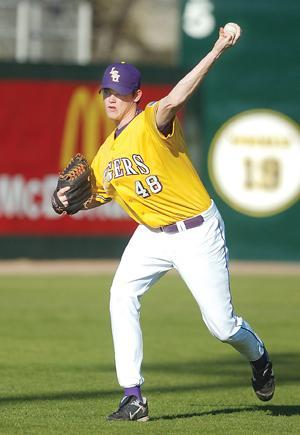Although sophomore guard Terry Martin, junior pitcher Charlie Furbush and junior third baseman Tayl’r Hollis play entirely different sports, two aspects of their lives tie them together. Each transferred to LSU from other universities and currently start for the LSU teams on which they play. While Martin and Hollis were forced to sit out and lose a year of eligibility for their decisions, the NCAA transfer rules have allowed Furbush the opportunity to start right away after transferring from St. Joseph’s College. And even though LSU baseball coach Paul Mainieri and his team have benefitted from Furbush’s 2-1 record and a strong start to the 2007 season, Mainieri said NCAA baseball transfer rules should be stricter. “It’s like an unbridled free agency,” Mainieri said. “With baseball transfer rules being as lenient as they are, players from any school can transfer at any time without consequences. If the university grants your release, you can be eligible to play immediately.” The NCAA Division I transfer bylaw 14.5.5.1 states, “A transfer student from a four-year institution shall not be eligible for intercollegiate competition at a member institution until the student has fulfilled a residence requirement of one full academic year (two full semesters or three full quarters) at the certifying institution. Further, a transfer student-athlete admitted after the 12th class day may not use that semester or quarter for the purpose of establishing residency.” But LSU Athletic Director Skip Bertman said the rule can be misleading. “You have to sit out one year if you play football, men’s and women’s basketball or ice hockey,” Bertman said. “With every other sport you can be eligible to play the next year if you meet certain circumstances.” “One-Time Transfer Exception” – Bylaw 14.5.5.2.10 – explains the “circumstances” Bertman referred to. It states that a student athlete who has not transferred previously from a four-year institute, participates in a sport other than basketball, Division I football or ice hockey, is in good academic standing and provides a written release from the university granting his/her release can transfer from one university to another without having to sit out and lose a year of eligibility. LSU basketball coach John Brady said the rule is too lenient for student-athletes and said something should be done to make all players that choose to transfer sit out an entire season. “If a young man leaves the school where he signed a scholarship, he should have to sit out a year,” Brady said. “Transfer rules in college athletics right now are even too easy on a guy that has to sit out a year. I’d hate to be the baseball coach where a guy can transfer if he doesn’t like the way a coach parts his hair, or if he doesn’t like the way he yelled at him one day, he can pack up and go somewhere else and immediately play the next year.” Brady addressed Martin’s success this season and his affect on the team but said he believes all players, including Martin, need to sit out an entire year before being eligible to play. Martin, who transferred from Texas Tech University after the fall 2005 semester, was forced to sit out a full academic year – two full semesters or three full quarters – before being allowed to return to the court Dec. 20, 2006, when LSU traveled to Seattle, Wash., to take on the University of Washington. Martin said he believes it is unfair that players such as Furbush can become immediately eligible to participate in the sport they play, but because of the NCAA transfer rules he could not play for half of his freshman and sophomore seasons. “It’s hard to sit out and stay in basketball shape,” Martin said. “It was hard for me because I had to sit out a year, and when I came back it was crunch time. Basketball teams play against easy teams at the beginning of the year to help them get ready and get team chemistry, but since I had to sit out, I had to jump right in.” Martin said he left Texas Tech and came to LSU because of the distance away from his family and said he was not allowed to transfer until Tech released him. “It was too far away from home, and my parents never got a chance to see me play,” Martin said. “I really didn’t like the city. I really didn’t like the school. I felt like it wasn’t the school for me, and I didn’t think college should be like that so I decided to come closer to home.” Mainieri – a member of the Baseball Issues Committee and Academic Enhancement Working Group, which study how to get baseball players from Division I schools to perform better academically – said 27 percent of college baseball players transferred this past year and added that these transfer athletes hurt the team’s Academic Performance Rate (APR). The APR is the score developed as an assessment of teams’ yearly academic performance. It awards two points each semester to student athletes who maintain their eligibility and return to the University for the following semester. “All those schools that these kids are transferring from are being penalized a point, and it’s not totally reflective on the academic performance of the baseball team,” Mainieri said. “This fall our baseball team had a 2.88 average grade point average. That’s the highest GPA the baseball team has had in the last 10 years. We’ve got a 2.88, but because people like Jared Bogany and Derik Olvey decide to transfer we get penalized two points in our APR. So that’s going to reflect as though it’s to say our kids aren’t performing academically, but in reality they are.” Mainieri said the way the rules are set up for college baseball has a negative affect on the universities from where the players transfer. “No matter how you look at it, transfers hurt the team,” Mainieri said. “Whether it’s losing a valuable player or effecting your APR, most of the time it has a negative effect on the team.”
—–Contact Jay St. Pierre at [email protected]
Separate but not equal
February 28, 2007

LSU baseball junior pitcher Charlie Furbush, who transferred from Saint Joseph’s College in Maine, throws a pitch Friday in the first game of the Tigers’ series against the University of Central Florida. LSU won the game, 4-1.





